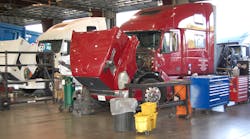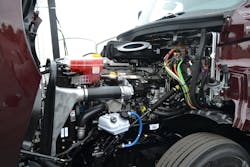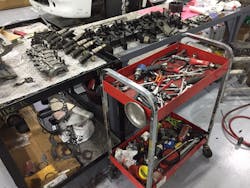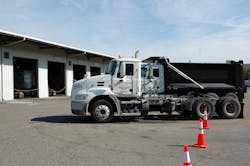A year into the ‘landmark’ right-to-repair agreement designed to provide independent truck service centers the same diagnostics and repair information the dealer networks receive (ensuring that truck operators have service options as a result), both sides say that progress is being made—but there’s still a lot to be done before this ticket can be closed.
At issue has been just how much truck data the original equipment manufacturers (OEMs) should provide to independent service centers and fleet shops. The vehicle makers have argued that they shouldn’t have to share proprietary performance information while the independents built a case that the practice made for an unfair marketplace: How could they repair a vehicle without it?
According to a 2010 survey by the American Trucking Assns.’ Technology and Maintenance Council, half of the fleets reported difficulty in getting the repair information they needed—and truck control systems have gotten even more complex since then.
To address the matter—and to forestall state-by-state battles and patchwork legislation—the OEMs and independents (primarily represented by the Truck and Engine Manufacturers Assn. (EMA) and the Commercial Vehicle Solutions Network (CVSN), respectively) got together to work out a deal.
A Memorandum of Understanding (MOU) was signed in September 2015, to take effect the following January, and Jed Mandel, EMA president, called it “a workable approach” to ensure “better and more timely access” to OEM-controlled repair information for the independent shops. Under the MOU, the independents agreed not to pursue additional right-to-repair legislation.
So, how’s it coming along?
“Based on my own observations, and member input, I believe that the MOU is working,” Mandel tells Fleet Owner. “Indeed, the universal feedback from EMA members is that they have not received any significant questions or complaints from independent service repair shops about access to information. Everyone has different systems. So, it is not surprising that the rollout—which is complex—is taking some time.”
Granted, the MOU was just “the first step in a long process” to provide parity in vehicle repair capability, as Marc Karon, a CVSN director and president of Total Truck Parts Inc., characterized it. He just didn’t fully grasp quite how long it would take, at the time.
“I think there’s a lot of impatience out there. And I’m personally a little disappointed it’s taken so long.
But it’s not that simple. It’s not a matter of flipping a switch.”
- Marc Karon, President of Total Truck Parts Inc.
“I think there’s a lot of impatience out there. And I’m personally a little disappointed it’s taken so long to do this,” he says. “Maybe I misunderstood, because I figured the software was already written—the dealers have it, so why can’t [the OEMs] just give it to us? But it’s not that simple. It’s not a matter of flipping a switch.”
The development of the heavy-duty vehicle MOU parallels right-to-repair proposals in the automotive sector. Essentially, the Clean Air Act required vehicles to have onboard computer systems to monitor vehicle emissions, and the OEMs had to provide independent shops the same emissions service information as they provided to the dealer service network. While legislation to broaden the scope of the service information to be shared—supported by independent repair and aftermarket trade groups and generally resisted by manufacturers and their dealers—was considered at the federal level as early as 2001, Massachusetts enacted the first Right to Repair bill in 2013. Auto industry interests got together for an MOU modeled on the Massachusetts law in 2014, and trucking followed a year later.
Details, details
Putting policy into practice has been challenging. Simply, each OEM’s repair system software is different. For example, if a manufacturer’s software is integrated into a broader dealer package, it has to create new software for independent service shops, Karon explains. Or, some manufacturers didn’t have a sales interface to make the package available.
“Every OEM has said they want to comply with MOU—it’s more or less getting the software written—but there’s been some confusion among the OEMs on what they really need to provide,” Karon says. “We have a great relationship with all the parties, and when we do get to talk to the OEMs, they’re very cooperative. And they have a lot of things going on in their business, too. It’s not up to me to set their priorities, or to say what software should be written first. It’s just going to take greater focus on everybody’s part. Nobody has said ‘we’re not going to do this.’”
The information gathered in testing has since been passed along to EMA and the sides are working out any compliance issues, Karon notes. And while the MOU does provide for an arbitrator to settle disputes, Karon anticipates any such disagreements will be worked out without having to go to arbitration.
Under the MOU, the National Automotive Service Task Force serves as the clearinghouse for the OEM software and as the designated “go-between” to bring questions from the service providers to the OEMs.
And to better implement the MOU and properly evaluate the OEM software packages, CVSN is forming an advisory group of service providers and fleet maintenance managers. “Any time a manufacturer comes out with something new, we have to vet it. It’s just becoming a very big project—and it’s one of the reasons we’re not further along,” Karon says. “We just didn’t have enough people.”
Karon made a pitch for volunteers at the recent Heavy-Duty Aftermarket Week event, and he’s following up with contacts from that show—but he’d still like more. He envisions quarterly conference calls to coordinate the efforts.
“We’re just asking for people to help us. If a guy has a Brand X truck in his shop and he has the software, he might alert us and ask what we need him to do or check to make sure the software works,” he says. “We can’t have too many people working on this. There’s so much software and, right now, so few people to actually evaluate it. We need the feedback to take to the OEMs.”
Technician training also has not moved as fast as Karon had hoped. “ Since the MOU does not provide for technician training on the software, CVSN worked with technician training companies to develop specific training in diagnosis and use of OEM software, but few fleets and service shops have taken advantage of this to date.”
“As an industry, people are not investing in training as much as they should—and this isn’t unique to the MOU. But if you’re not taking advantage of this training—it’s very inexpensive—you’re missing a big opportunity.”
The good news is that the post-MOU transition has had little impact on diagnostic and repair tool providers, explains Tim Bigwood, COO for vehicle data experts Noregon. The company features the widely used JPRO Professional among its offerings and has for years worked directly with the OEMs and component suppliers to provide its comprehensive all-makes and models diagnostic tool.
“The tricky part is what data should be available and at what cost to the scan tool manufacturers,” Bigwood says. “Each OEM seems to have a different perspective on the data, ranging from minimal to all-encompassing, and costing ranges from minimal to very expensive. Unless there is some standardization on the available data and cost, we don’t see any major changes in the near future as [the MOU] relates to the scan tool manufacturers.”
“You’re going to be more and more dependent on third parties to get the service that you need,” Riemer says. “It will be an interesting dilemma.”
Telematics
While telematics data is not part of the agreement, proprietary OEM systems can be problematic for fleets that run a mix of brands—and aftermarket providers are positioning themselves as a single-source solution. The keys will still be “fairness in the marketplace” and “restraint of trade,” CVSN’s Karon suggests.
“I’m not sure where telematics is going to wind up,” Karon says. “There could be some legislative effort in the future to make telematics more available, especially at the automotive level. The automotive providers will drive that, and that will then carry over to the heavy-duty side. But I’m not sure there’s going to be an issue, as long as fleets have an option on who they’re going to do business with.”
For Noregon’s Bigwood, the data that is currently accessible to the telematics service providers (TSPs) is adequate for the applications available today. Noregon’s TripVision, for example, allows for a comprehensive real-time view into a vehicle’s health and safety based upon the existing data feed from TSPs.
“As applications that require vehicle data such as over-the-air reprogramming and on-the-fly condition-based maintenance continue to evolve, TSPs will need to work closely in partnership with the OEMs to bring these products to market,” he says.
But with “predictive analytics” widely predicted to be The Next Big Thing—and with vehicle performance and reliability seen as areas ripe for such technology—the distinction between what’s essential repair information and what’s not essential becomes less obvious.
“Predictive analytics is very interesting,” says Decisiv’s Riemer. “If I’m an OEM, and you send me back a turbo that’s not broken, but your algorithm said it was going to break soon, why would I do the warranty on that? There’s a Catch-22 on not only who can access the information, but what you can actually use it for.”
So while an OEM would be wise to invest in “condition-based” maintenance, or predictive repairs, it’s not clear that the OEM should be required to honor such a prediction from a third party, Riemer suggests.
“I’m generally in favor, in today’s world, of sharing as much information as possible. Trucks are commercial assets and are fairly complex pieces of machinery with lots of associated intellectual property—it’s not cars, or that’s the argument the truck OEMs make—so I’m not sure we’ll get to that same level of homogeneous access.”
Still, at least according to more than a few business presentation slide-decks, “information is the new currency,” and Riemer goes on to explain that as a company whose business is based on being a “connector”—of people and technology—Decisiv isn’t in a position to dictate “who should get what,” although he can see both sides of the argument.
“All I know, from our experience, is the more information you have at the point of service, the better, the faster, and the more reliable the repair process is,” Riemer says. “I’m sure there’s lots of information about that asset that’s not valuable for that service event, but the operational performance of that asset is absolutely critical to making the best decisions and the fastest diagnosis.
“The amount of that information is only going to increase, and the impact of that information is only going to increase. The question is, who’s going to get access to it and where does it apply? If it’s that valuable, I can imagine being very protective of it.”








